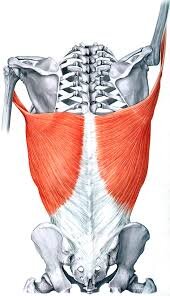WE'RE ALL JUST ORANGES
We’re All Just Oranges
A Basic Intro to Fascia
WHAT IS FASCIA??
Throughout my time at University, many hours were spent in the dissection labs, analysing human anatomy from the outside in. We broke these labs up into ‘sections’ of the body – one week on the reproductive tract, one on the digestive tract, one on the musculoskeletal network – you get my drift.
Thanks to the kind men and women that donated their bodies to science, we were able to get a real understanding of what goes on inside our generally well-oiled machines that we operate for hopefully 90+ years.
Image courtesy of CoreWalking
When you ‘dissect’ a cadaver, you peel away the top layer and analyse what is within. So looking at the latissimus dorsi below (you may know these muscles as the ‘Lats’) you get an appreciation of where it attaches and what it does when it is activated.
What we have failed to acknowledge to its fullest extent over the recent years is that top layer that was peeled back. What connects your hip flexor to your diaphragm, what connects the sack around your heart to the muscles around your throat?
It’s the fascia.
The best explanation I’ve heard for fascia is from Thomas Myers, the ‘King of fascia’. “You can just think of it like an orange. Each drop of juice is contained within one of those little cells. Those cells are contained within the section, that sections is contained within the pith and the pith is contained within the rind. “ It’s the reason that the 60-70% of us that is made up of water isn’t a puddle on the ground.
Fascia provides a connective network between each and every part of our body, from muscle to tendon to ligament to bone to nerve and so on. And if you’ve ever been to a physio, chiro or osteopath and they’ve said something along the lines of “Your pain is linked to tightness somewhere else on the body”, that’s them recognising to some extent the role fascia plays, though probably not realising just how intricately.
If we look back to the previous picture of the Lats with the orange analogy in our minds, the question still remains...
WHERE’S THE FASCIA?
It’s been peeled back, and as a result we make this distinction in our head that each muscle operates of its own accord. That somehow, when we’re swinging a bat, running a sprint, shooting hoops, the lats don’t connect to the glutes, that the whole musculo-tendino-ligamentous network works in isolation from one another.
Now take a look at the next picture. Thanks to some researchers well ahead of their time, they had a thought… What if, instead of cutting between each muscle, we try and find out why they’re attached in the first place? And voila; below we can see the result.
Image courtesy of Anatomy Trains ©
In this instance, there is quite an obvious relationship between the lats on one side and the gluteus maximus on the other. Together they give us most of our power in nearly any moving activity we perform, and we call this the Posterior Oblique Sling. It is one of just many lines of muscle in the body, and should change the way we look to train.
In our next post, we will begin to look at each sling, and begin to address the common problems within.
If you are following along this series of blogs, here are some questions to stimulate a bit of thought before the next post:



